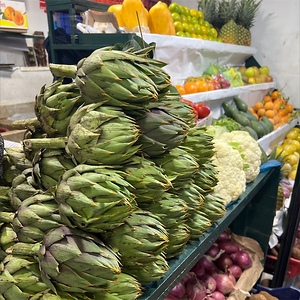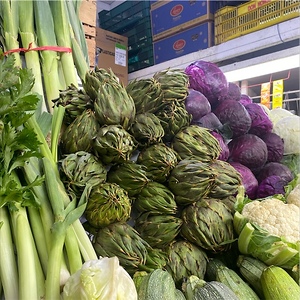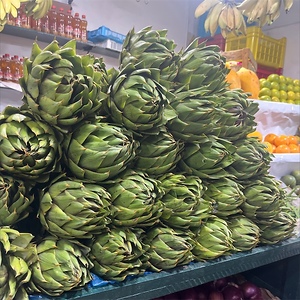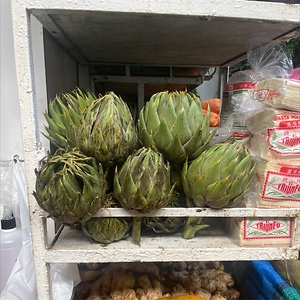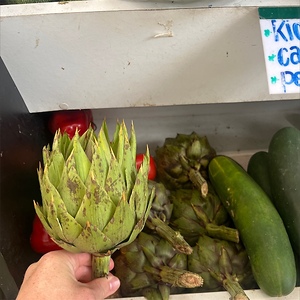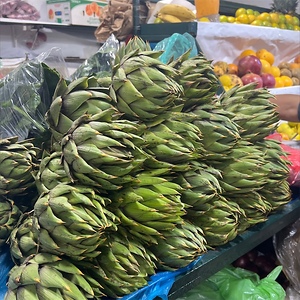


Peruvian Artichokes
Estimated Inventory, lb : 0
Description/Taste
Peruvian artichokes have a globular, tapered shape, averaging 8-15 centimeters in diameter, and consist of many layers of triangular, pointed bracts. The thick, green bracts are fleshy, slightly curved, and sharp with small spines on the tips. As each layer is peeled away, the color of the bracts transforms from green to yellow-purple, and each bract grows smaller and smaller towards the interior, revealing a central heart and many tiny, immature flower buds. When cooked, Peruvian artichokes develop a soft and tender, edible flesh at the bottom of each bract with a green, nutty, and slightly tangy flavor.
Seasons/Availability
Peruvian artichokes are available in the late winter through early spring when grown along the coast, and again in the fall when grown in the highlands of Peru.
Current Facts
Peruvian artichokes, botanically classified as Cynara scolymus, are the edible flower buds of a thistle-like plant that can grow up to two meters in height and belongs to the Asteraceae family. Also known as Criolla Globe artichokes and Spine artichokes, Peruvian artichokes are well-suited to the diverse Peruvian climate and can grow in both coastal and highland regions providing a year-round supply. Cultivated predominately for export, Peruvian artichokes are favored for their tangy, green flavor and are utilized as a healthy addition to appetizers and main courses.
Nutritional Value
Peruvian artichokes are an excellent source of fiber and also contain vitamins C and K, magnesium, iron, potassium, and manganese.
Applications
Peruvian artichokes are incredibly versatile and can be steamed, baked, braised, boiled, and grilled. The spines should be removed from each bract before cooking, and the artichoke can be cooked whole or sliced in half and stuffed with cheese and meat. When served whole, each bract can be removed, and the fleshy bottom can be dipped in sauces such as mayonnaise, balsamic vinegar, butter, olive oil, or served with lemon juice. Peruvian artichokes can also be utilized for the central heart, and the hearts can be cooked and topped with cheese served as an appetizer, mixed into pasta, stuffed into empanadas, tossed into salads, or sprinkled on pizza. They can also be cooked into paella, incorporated into grain bowls, or sautéed into egg-based dishes. Peruvian artichokes pair well with potatoes, celery, carrots, mushrooms, parsley, garlic, olives, white wine, mozzarella cheese, aioli, and citrus. The artichokes will keep 5-7 days when placed in a sealed container, sprinkled with water, and stored in the refrigerator.
Ethnic/Cultural Info
Peru is one of the largest producers of artichokes outside of the Mediterranean, and Peruvian artichokes are predominately grown for export to the United States and Europe. Many of the artichokes are sent to the canning industry where the hearts are removed and sold by themselves, or the artichokes are exported fresh or frozen for culinary use. Beyond exporting, Peruvian artichokes are also found in local Peruvian markets where they are displayed in large piles to showcase their unusual shape and fresh attributes. In some markets, the artichoke hearts are also removed and preserved in citrus water to allow for consumers to have immediate access to the tender, tangy flesh. In Peru, artichokes are commonly made into a paste and are baked into a tart, used as a stuffing in papa rellenas, sliced and mixed into avocado soup, or even formed into an artichoke flan.
Geography/History
Artichokes are native to the Mediterranean and have been growing wild since ancient times. They were mainly localized to the Mediterranean until the 19th century when European immigrants introduced the plant to South America where it became highly naturalized in Peru. Today Peruvian artichokes are found growing wild and are cultivated on a small scale in the regions of Junin, Arequipa, Huancavelica, Cajamarca, Ancash, and Ayacucho in Peru.
Recipe Ideas
Recipes that include Peruvian Artichokes. One



